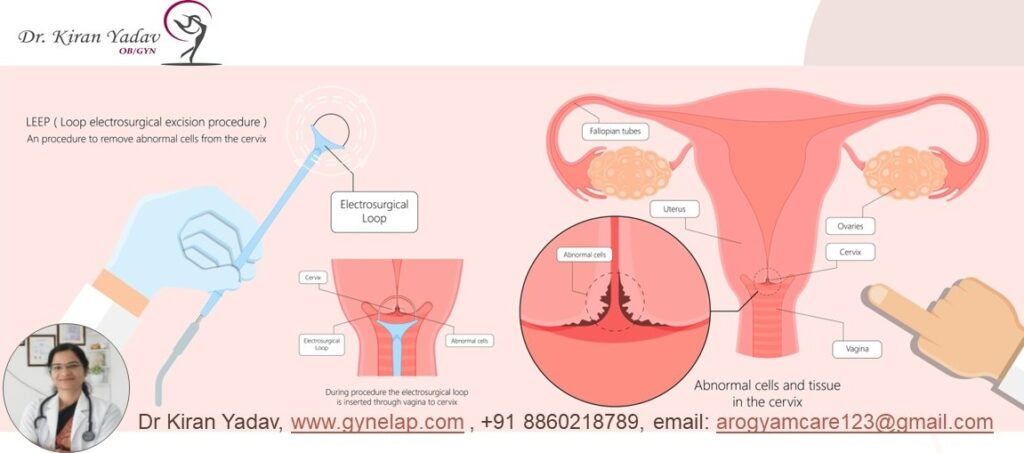Loop Electrosurgical Excision Procedure (LEEP): A Comprehensive Overview
The Loop Electrosurgical Excision Procedure (LEEP) is a common and effective treatment used to remove abnormal or precancerous cells from the cervix. LEEP is particularly valuable for addressing cervical dysplasia, a condition where abnormal cells are found on the surface of the cervix. By removing these abnormal cells, LEEP helps prevent the development of cervical cancer. Here’s a detailed look at LEEP, how it works, and what patients can expect.
1. What is LEEP?
The Loop Electrosurgical Excision Procedure uses a thin, low-voltage electrified wire loop to precisely excise abnormal cervical tissue. The electrical current heats the wire loop, allowing it to cut away the affected tissue while simultaneously sealing blood vessels to minimize bleeding. The procedure is usually performed in an outpatient setting and is quick, often taking less than 30 minutes to complete.
2. Indications for LEEP
LEEP is typically recommended when a Pap smear or biopsy indicates the presence of high-grade cervical dysplasia or when precancerous changes are detected. The primary indications for LEEP include:
Cervical Intraepithelial Neoplasia (CIN): CIN is classified into grades I, II, and III based on the severity of abnormal cell growth. LEEP is often used for CIN II and III, which have a higher risk of progressing to cervical cancer.
Persistent Abnormal Pap Smear Results: When Pap smear results consistently show abnormalities that suggest a risk of progression to cancer, LEEP may be recommended.
HPV Infection: Persistent infection with high-risk types of HPV that cause significant changes in cervical cells may also warrant LEEP.
3. How is LEEP Performed?
The Loop Electrosurgical Excision Procedure is usually done under local anesthesia, although some patients may receive a mild sedative to help them relax. Here’s what happens during the procedure:
Preparation: The patient lies on an exam table in a position similar to that of a Pap smear. A speculum is inserted into the vagina to expose the cervix.
Anesthesia: A local anesthetic is injected into the cervix to numb the area and minimize discomfort.
Colposcopy: A colposcope (a specialized microscope) is used to closely examine the cervix. A vinegar solution or iodine may be applied to highlight abnormal cells.
Removal of Abnormal Tissue: The electrified loop wire is carefully guided to the affected area of the cervix. The abnormal tissue is excised using the loop, which cuts and cauterizes simultaneously.
Tissue Collection: The excised tissue is collected and sent to a laboratory for histopathological analysis to ensure that all abnormal cells have been removed and to check for the presence of cancer.
Aftercare: A special solution or paste may be applied to the cervix to help prevent bleeding. The speculum is removed, and the patient is allowed to rest briefly before going home.
4. Recovery After LEEP
Recovery from LEEP is typically quick, with most patients resuming normal activities within a few days. However, some aftercare guidelines are essential to promote healing and prevent complications:
Rest: Patients are advised to rest for the first day or two after the procedure.
Vaginal Discharge: Mild cramping and a dark brown or bloody discharge are common for a few weeks after LEEP as the cervix heals. This discharge is due to the application of the solution or paste to control bleeding.
Avoiding Certain Activities: To reduce the risk of infection and promote healing, patients should avoid inserting anything into the vagina (e.g., tampons, douching) and abstain from sexual intercourse for about 4-6 weeks, or as directed by their healthcare provider.
Follow-Up Appointments: Regular follow-up visits are crucial to monitor healing and ensure that no abnormal cells remain. Pap smears and HPV testing are usually repeated within 6 months to a year after the procedure.
5. Risks and Complications of LEEP
While The Loop Electrosurgical Excision Procedure is generally safe, like any surgical procedure, it carries some risks. Potential complications include:
Infection: There is a small risk of infection after Loop Electrosurgical Excision Procedure (LEEP), which can be minimized by following post-procedure care instructions and avoiding activities that could introduce bacteria into the vagina.
Bleeding: Some bleeding is normal after LEEP, but excessive bleeding may occur. Patients should contact their healthcare provider if they experience heavy bleeding or pass large clots.
Cervical Stenosis: In rare cases, LEEP can lead to cervical stenosis, a narrowing of the cervix, which may affect menstrual flow or fertility.
Preterm Birth: Some studies suggest that LEEP may slightly increase the risk of preterm birth or having a low birth weight baby in future pregnancies. However, the benefits of removing precancerous cells usually outweigh these risks.
6. Benefits of LEEP
Loop Electrosurgical Excision Procedure (LEEP) offers several advantages as a treatment for abnormal cervical cells:
High Success Rate: LEEP is highly effective at removing abnormal tissue, with success rates ranging from 90% to 95% for eliminating high-grade dysplasia.
Minimally Invasive: The procedure is relatively simple and minimally invasive, often requiring only local anesthesia and minimal recovery time.
Preservation of Cervical Function: LEEP preserves the majority of the cervix, allowing it to maintain its normal function, which is particularly important for women who wish to have children in the future.
Diagnostic Benefits: In addition to treatment, LEEP provides a tissue sample for histological examination, allowing for accurate diagnosis and assessment of the extent of abnormal cell changes.
Conclusion
The Loop Electrosurgical Excision Procedure (LEEP) is an effective and commonly used method for treating abnormal cervical cells and preventing the progression to cervical cancer. By removing precancerous tissue, LEEP plays a critical role in the early intervention and management of cervical dysplasia. Patients undergoing LEEP should follow their healthcare provider’s recommendations for post-procedure care and attend regular follow-up appointments to ensure their continued health and well-being. Through LEEP and other preventive measures, the risk of developing cervical cancer can be significantly reduced, improving outcomes and quality of life for many women.





